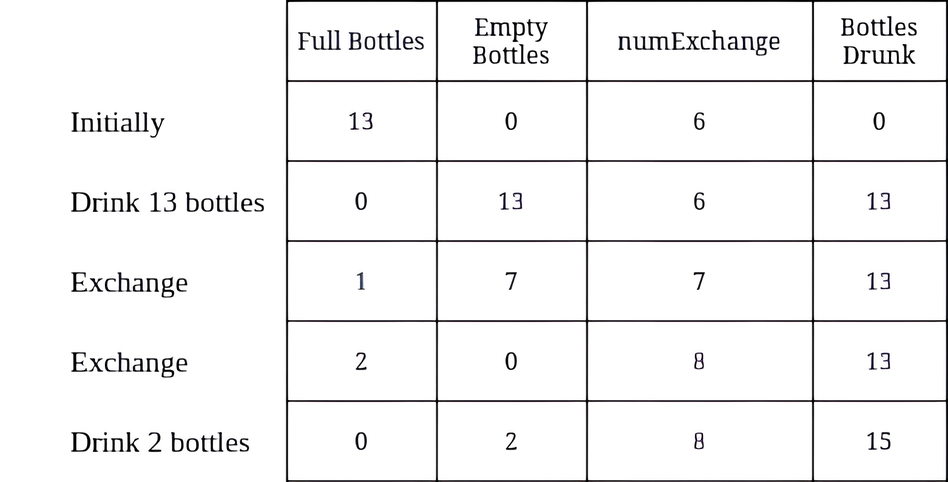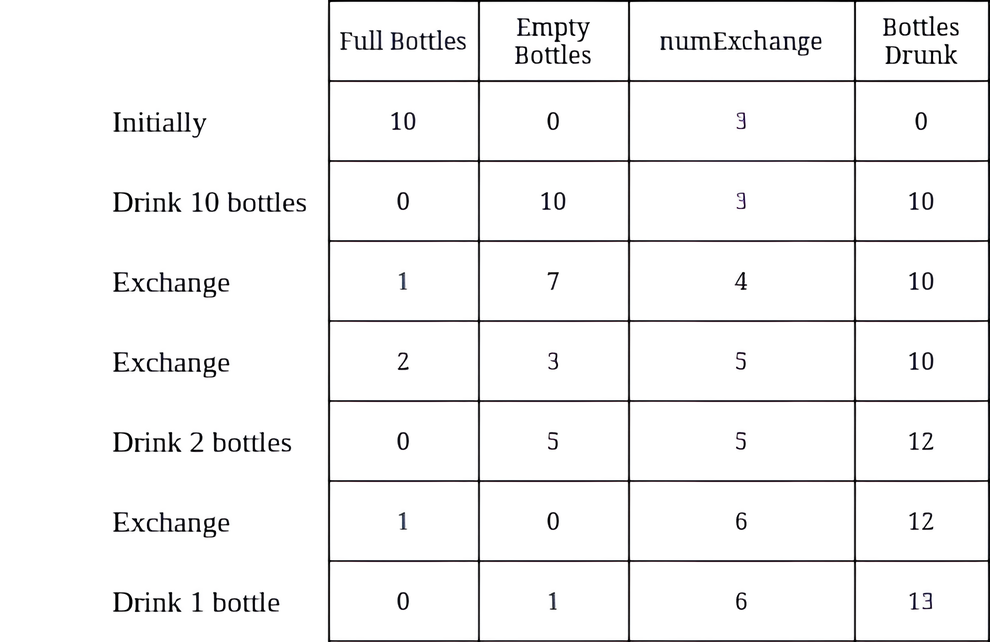leetcode contest 391 虽然没参加周赛,但是 T4 确实是个模版题目,基本上知道的知识点就非常容易。
3099. 哈沙德数 如果一个整数能够被其各个数位上的数字之和整除,则称之为 哈沙德数 (Harshad number)。给你一个整数 x 。如果 x 是 哈沙德数 ,则返回 x 各个数位上的数字之和,否则,返回 -1 。
示例 1:
输入: x = 18
输出: 9
解释:
x 各个数位上的数字之和为 9 。18 能被 9 整除。因此 18 是哈沙德数,答案是 9 。
示例 2:
输入: x = 23
输出: -1
解释:
x 各个数位上的数字之和为 5 。23 不能被 5 整除。因此 23 不是哈沙德数,答案是 -1 。
提示:
地址 https://leetcode.cn/contest/weekly-contest-391/problems/harshad-number/
题意 直接模拟
思路
直接统计数字中每一位的和,检测是否能被 $x$ 整除即可。
复杂度分析:
时间复杂度:$O(\log x)$,其中 $x$ 表给定的数。
空间复杂度:$O(1)$,。
代码 class Solution : def sumOfTheDigitsOfHarshadNumber (self, x: int ) -> int : s = sum (ord (c) - ord ('0' ) for c in str (x)) return s if x % s == 0 else -1
impl Solution { pub fn sum_of_the_digits_of_harshad_number (x: i32 ) -> i32 { let mut sum = 0 ; let mut a = x; while a > 0 { sum += a % 10 ; a /= 10 ; } if x % sum == 0 {sum} else {-1 } } }
3100. 换水问题 II 给你两个整数 numBottles 和 numExchange 。
numBottles 代表你最初拥有的满水瓶数量。在一次操作中,你可以执行以下操作之一:
喝掉任意数量的满水瓶,使它们变成空水瓶。
用 numExchange 个空水瓶交换一个满水瓶。然后,将 numExchange 的值增加 1 。
注意,你不能使用相同的 numExchange 值交换多批空水瓶。例如,如果 numBottles == 3 并且 numExchange == 1 ,则不能用 3 个空水瓶交换成 3 个满水瓶。
返回你 最多 可以喝到多少瓶水。
示例 1:
输入:numBottles = 13, numExchange = 6 输出:15 解释:上表显示了满水瓶的数量、空水瓶的数量、numExchange 的值,以及累计喝掉的水瓶数量。
示例 2:
输入:numBottles = 10, numExchange = 3 输出:13 解释:上表显示了满水瓶的数量、空水瓶的数量、numExchange 的值,以及累计喝掉的水瓶数量。
提示:
1 <= numBottles <= 1001 <= numExchange <= 100
地址 https://leetcode.cn/contest/weekly-contest-391/problems/water-bottles-ii/
题意 数学问题 + 模拟
思路
由于给定的数值较小,我们直接按照题目要求进行模拟即可。
复杂度分析:
时间复杂度:$O(n \times \log n)$,其中 $n$ 表示给定数组的长度。
空间复杂度:$O(\log n)$。
代码 impl Solution { pub fn max_bottles_drunk (num_bottles: i32 , num_exchange: i32 ) -> i32 { let mut num_exchange = num_exchange; let mut res = num_bottles; let mut tot = num_bottles; while tot >= num_exchange { res += 1 ; tot -= num_exchange - 1 ; num_exchange += 1 ; } res } }
class Solution : def maxBottlesDrunk (self, numBottles: int , numExchange: int ) -> int : res, tot = numBottles, numBottles while tot >= numExchange: res += 1 tot -= numExchange - 1 numExchange += 1 return res
3101. 交替子数组计数 给你一个二进制数组 nums 。
如果一个子数组中 不存在 两个 相邻 元素的值 相同 的情况,我们称这样的子数组为 交替子数组 。
返回数组 nums 中交替子数组的数量。
示例 1:
输入: nums = [0,1,1,1]
输出: 5
解释:
以下子数组是交替子数组:[0] 、[1] 、[1] 、[1] 以及 [0,1] 。
示例 2:
输入: nums = [1,0,1,0]
输出: 10
解释:
数组的每个子数组都是交替子数组。可以统计在内的子数组共有 10 个。
提示:
1 <= nums.length <= 105nums[i] 不是 0 就是 1 。
地址 https://leetcode.cn/contest/weekly-contest-391/problems/count-alternating-subarrays/
题意
数学
思路
感觉是个比较容易得题目,我们每次计算以当前位置 $i$ 为结尾的且构成交替子数组的长度为 $cnt$,则此时以 $i$ 为结尾可以构成的交替子数组的数目也为 $cnt$ 个,我们依次统计当前的交替子数组即可。感觉算是个简单题目。
复杂度:
时间复杂度:$O(n)$,其中 $n$ 表示给定数组的长度;
空间复杂度:$O(1)$;
代码 class Solution : def countAlternatingSubarrays (self, nums: List [int ] ) -> int : n = len (nums) tot, res = 1 , 1 for i in range (1 , len (nums)): tot = 1 if nums[i] == nums[i - 1 ] else tot + 1 res += tot return res
impl Solution { pub fn count_alternating_subarrays (nums: Vec <i32 >) -> i64 { let mut tot = 1 ; let mut res = 1 as i64 ; for i in 1 ..nums.len () { tot = if nums[i] == nums[i - 1 ] {1 } else {tot + 1 }; res += tot as i64 ; } return res; } }
3102. 最小化曼哈顿距离 给你一个下标从 0 开始的数组 points ,它表示二维平面上一些点的整数坐标,其中 points[i] = [xi, yi] 。
两点之间的距离定义为它们的曼哈顿距离。
请你恰好移除一个点,返回移除后任意两点之间的 最大 距离可能的 最小 值。
示例 1:
输入:points = [[3,10],[5,15],[10,2],[4,4]] 输出:12 解释:移除每个点后的最大距离如下所示: - 移除第 0 个点后,最大距离在点 (5, 15) 和 (10, 2) 之间,为 |5 - 10| + |15 - 2| = 18 。 - 移除第 1 个点后,最大距离在点 (3, 10) 和 (10, 2) 之间,为 |3 - 10| + |10 - 2| = 15 。 - 移除第 2 个点后,最大距离在点 (5, 15) 和 (4, 4) 之间,为 |5 - 4| + |15 - 4| = 12 。 - 移除第 3 个点后,最大距离在点 (5, 15) 和 (10, 2) 之间的,为 |5 - 10| + |15 - 2| = 18 。 在恰好移除一个点后,任意两点之间的最大距离可能的最小值是 12 。
示例 2:
输入:points = [[1,1],[1,1],[1,1]] 输出:0 解释:移除任一点后,任意两点之间的最大距离都是 0 。
提示:
3 <= points.length <= 105points[i].length == 21 <= points[i][0], points[i][1] <= 108
地址 https://leetcode.cn/contest/weekly-contest-391/problems/minimize-manhattan-distances/
题意
数学
思路
直接暴力计算的话,时间复杂度为 $O(n^2)$,题目的关键在于求集合中曼哈顿零距离的变形,此时我们可以根据公式可知:
复杂度分析:
时间复杂度:$O(n\log n)$,其中 $n$ 表示给定的点的数目;
空间复杂度:$O(n)$,其中 $n$ 表示数组的长度;
代码 class Solution : def minimumDistance (self, points: List [List [int ]] ) -> int : n = len (points) add, sub = [], [] for i, (x, y) in enumerate (points): add.append([x + y, i]) sub.append([x - y, i]) add.sort() sub.sort() x = add[-1 ][0 ] - add[0 ][0 ] y = sub[-1 ][0 ] - sub[0 ][0 ] res = inf i, j = 0 , 0 if x >= y: i, j = add[0 ][1 ], add[-1 ][1 ] else : i, j = sub[0 ][1 ], sub[-1 ][1 ] def calc (nums, i ): if nums[0 ][1 ] == i: return nums[-1 ][0 ] - nums[1 ][0 ] elif nums[-1 ][1 ] == i: return nums[-2 ][0 ] - nums[0 ][0 ] else : return nums[-1 ][0 ] - nums[0 ][0 ] res = min (res, max (calc(add, i), calc(sub, i))) res = min (res, max (calc(add, j), calc(sub, j))) return res
use std::cmp::min;use std::cmp::max;impl Solution { pub fn minimum_distance (points: Vec <Vec <i32 >>) -> i32 { let n = points.len (); let mut add : Vec <[i32 ; 2 ]> = Vec ::new (); let mut sub : Vec <[i32 ; 2 ]> = Vec ::new (); for (i, point) in points.iter ().enumerate () { let x = point[0 ]; let y = point[1 ]; add.push ([x + y, i as i32 ]); sub.push ([x - y, i as i32 ]); } add.sort_by (|a, b| a.cmp (b)); sub.sort_by (|a, b| a.cmp (b)); let x = add.last ().unwrap ()[0 ] - add.first ().unwrap ()[0 ]; let y = sub.last ().unwrap ()[0 ] - sub.first ().unwrap ()[0 ]; let mut res = i32 ::MAX; let (mut i, mut j) = (0 , 0 ); if x >= y { i = add.first ().unwrap ()[1 ] as usize ; j = add.last ().unwrap ()[1 ] as usize ; } else { i = sub.first ().unwrap ()[1 ] as usize ; j = sub.last ().unwrap ()[1 ] as usize ; } fn calc (nums: &Vec <[i32 ; 2 ]>, i: usize ) -> i32 { if nums.first ().unwrap ()[1 ] == i as i32 { return nums.last ().unwrap ()[0 ] - nums[1 ][0 ]; } else if nums.last ().unwrap ()[1 ] == i as i32 { return nums[nums.len () - 2 ][0 ] - nums.first ().unwrap ()[0 ]; } else { return nums.last ().unwrap ()[0 ] - nums.first ().unwrap ()[0 ]; } } res = min (res, max (calc (&add, i), calc (&sub, i))); res = min (res, max (calc (&add, j), calc (&sub, j))); res } }
欢迎关注和打赏,感谢支持!



